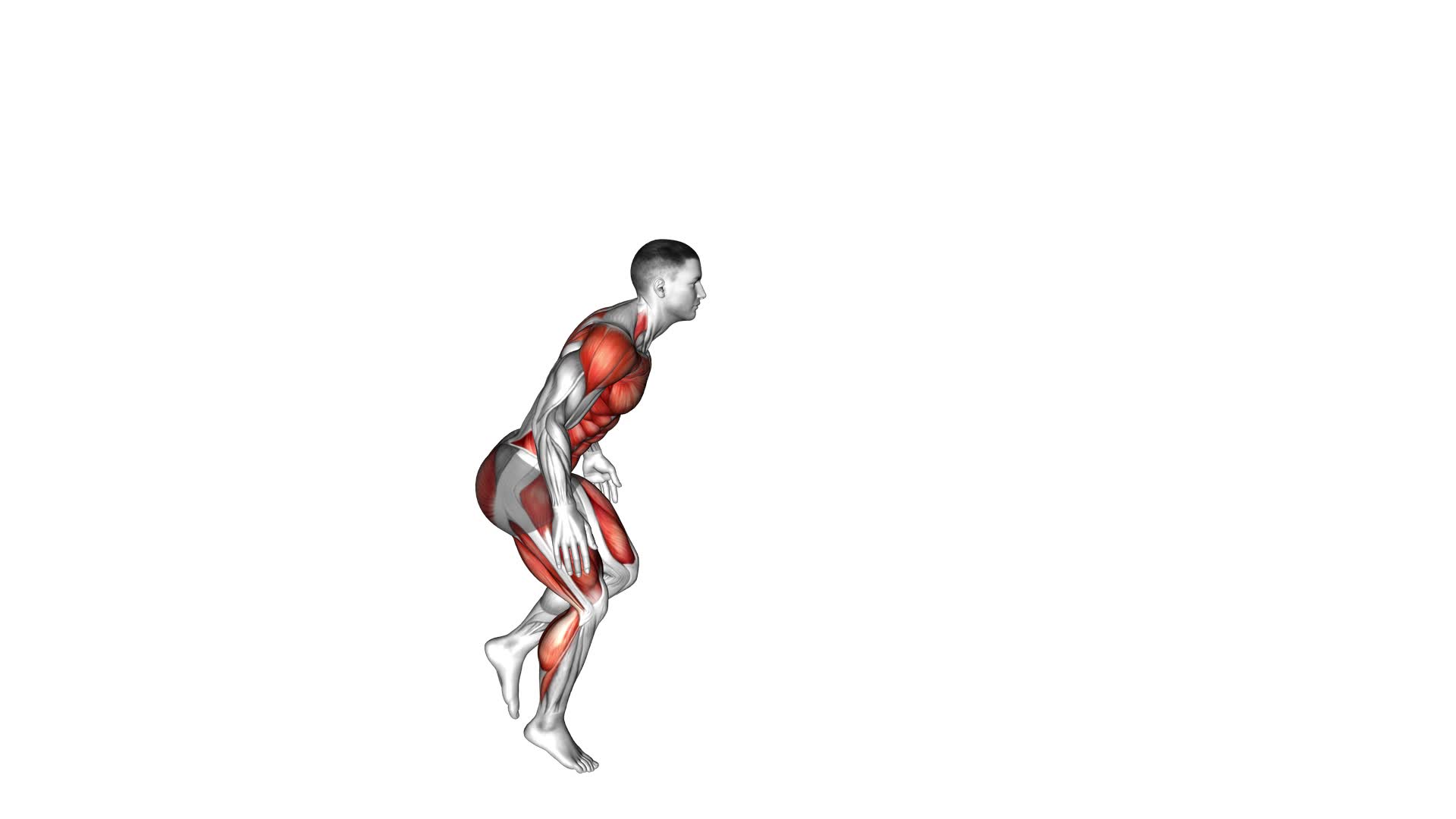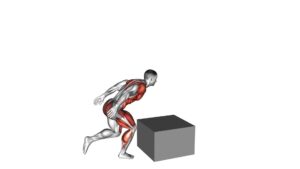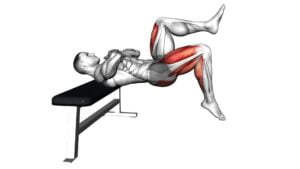Single Leg Board Jump – Video Exercise Guide & Tips

Are you looking for a challenging exercise to level up your fitness routine? Look no further than the Single Leg Board Jump!
Watch This Exercise Video
In this video exercise guide, we'll show you the proper form and technique to get the most out of this move.
Learn about the benefits, common mistakes to avoid, and tips to increase the challenge.
Whether you're a beginner or have limitations, we've got safety precautions and modifications covered.
Let's jump into it!
Key Takeaways
- Increased vertical jump
- Strengthening of leg muscles (quadriceps, hamstrings, and calves)
- Improved balance and stability
- Potential for improved performance in sports and activities
Benefits of the Single Leg Board Jump
There are three main benefits of performing the Single Leg Board Jump.
First, it can lead to an increased vertical jump. By focusing on jumping off one leg, you're targeting the muscles responsible for explosive power. This exercise helps to strengthen your leg muscles, specifically the quadriceps, hamstrings, and calves, which are crucial for generating upward force. As a result, your vertical jump height can significantly improve.
Second, the Single Leg Board Jump is an effective way to improve balance and stability. When you jump off one leg onto a board, it requires you to engage your core muscles and maintain proper body alignment. This exercise challenges your proprioceptive abilities and enhances your overall balance and stability.
Incorporating the Single Leg Board Jump into your training routine can have numerous benefits. It can increase your vertical jump height, allowing you to excel in sports that demand explosive power. Additionally, it improves your balance and stability, which can enhance your performance in various activities.
Make sure to include this exercise in your workouts to reap these benefits and take your athleticism to new heights.
Proper Form and Technique for the Exercise
To perform the Single Leg Board Jump with proper form and technique, focus on maintaining a stable core and a balanced posture throughout the exercise. This won't only help in improving balance but also increasing power.
Start by standing on one leg with your knee slightly bent and your foot positioned at the center of the board. Engage your core muscles to stabilize your body. From here, bend your knee and push off with your standing leg, driving upwards and forwards. As you jump, swing your arms forward to generate momentum.
Land softly on the board with your knee slightly bent, absorbing the impact with your leg muscles. Throughout the exercise, keep your body upright and avoid leaning forward or backward. Maintain a controlled and smooth movement, focusing on the muscles in your leg and core.
Common Mistakes to Avoid While Performing the Single Leg Board Jump
When performing the Single Leg Board Jump, it's important to know the common mistakes to avoid in order to maintain proper form and technique. Here are some common mistakes to watch out for:
- Landing with a flat foot: Ensure that you land on the ball of your foot to absorb the impact and maintain stability. Landing with a flat foot can put unnecessary strain on your joints.
- Leaning forward: Keep your torso upright throughout the exercise. Leaning forward can compromise your balance and increase the risk of falling.
- Not using your arms: Your arms play a crucial role in generating power and momentum for the jump. Swing your arms forward and upward as you jump to maximize your jump height.
- Not engaging your core: Your core muscles should be activated during the jump to provide stability and control. Neglecting to engage your core can lead to instability and poor form.
- Not progressing gradually: It's important to gradually increase the difficulty of the exercise as you get stronger and more proficient. Jumping onto higher boards before you're ready can increase the risk of injury.
Tips to Increase the Challenge and Intensity of the Exercise
To increase the challenge and intensity of the exercise, incorporate higher and more unstable boards. Progression options for the single leg board jump include using a higher platform or board. This will require you to jump higher and engage your leg muscles more intensely. You can also try using a wobble board or a balance board to make the exercise more unstable, forcing your muscles to work harder to stabilize your body.
Another advanced variation is to add weights to the exercise. Holding dumbbells or wearing ankle weights while performing the single leg board jump will increase the resistance and further challenge your muscles.
Incorporating these progression options and advanced variations will help you push your limits and continue to make progress with the single leg board jump. However, it's important to note that safety should always be a priority. Make sure you're using proper form and technique before attempting any advanced variations.
In the next section, we'll discuss safety precautions and modifications for beginners or those with limitations, so you can perform the single leg board jump in a safe and effective manner.
Safety Precautions and Modifications for Beginners or Those With Limitations
For beginners or those with limitations, it's important to take necessary safety precautions and make modifications when performing the single leg board jump. This exercise can be challenging and may put strain on your joints if not done correctly.
Here are some beginner modifications and injury prevention tips to help you perform the exercise safely:
- Start with a lower platform: Use a lower step or platform to reduce the height of the jump and make it easier on your joints.
- Use a support: Hold onto a stable object, such as a railing or wall, to provide balance and support during the exercise.
- Focus on technique: Prioritize proper form and technique over speed or height. This will help you build strength and stability while minimizing the risk of injury.
- Listen to your body: Pay attention to any discomfort or pain during the exercise. If something doesn't feel right, stop and consult a professional.
- Progress gradually: Gradually increase the height of the platform and the intensity of the exercise as your strength and balance improve.
By following these modifications and safety precautions, you can safely perform the single leg board jump and avoid potential injuries.
Remember to always warm up before exercising and consult with a healthcare professional if you have any concerns or limitations.
Frequently Asked Questions
How Many Calories Does the Single Leg Board Jump Burn?
The single leg board jump is an effective exercise for burning calories and aiding in weight loss. By incorporating explosive jumps on a single leg, this exercise engages multiple muscle groups and increases heart rate, resulting in a higher calorie burn.
In addition to its calorie-burning benefits, the single leg board jump also improves balance, coordination, and lower body strength. Incorporating this exercise into your routine can help you reach your weight loss goals.
Can the Single Leg Board Jump Help Improve Agility and Balance?
The single leg board jump is a great exercise for improving agility and balance. By focusing on one leg at a time, you challenge your coordination and stability.
This exercise also offers the benefits of single leg exercises, such as increased strength and stability in the lower body.
Incorporating the single leg board jump into your workout routine can help you become more agile and balanced, leading to improved overall fitness.
Is It Necessary to Use a Specific Type of Board for the Exercise?
Using a specific type of board for the single leg board jump exercise isn't necessary, but it can offer additional benefits.
Different board options, such as balance boards or wobble boards, can provide a more unstable surface, challenging your balance and stability even further. This can help improve your overall agility and proprioception.
However, if you don't have access to a specific board, you can still perform the exercise on a regular flat surface and still reap the benefits.
Can the Single Leg Board Jump Be Incorporated Into a Full-Body Workout Routine?
Incorporating the single leg board jump into your full body workout routine can provide numerous benefits.
This exercise targets your lower body muscles, including your glutes, quads, and calves, while also engaging your core for stability.
By jumping onto a board with one leg, you'll improve your balance, coordination, and explosive power.
Additionally, the single leg board jump adds a plyometric element to your workout, which can enhance your cardiovascular endurance and calorie burn.
Are There Any Alternatives or Variations to the Single Leg Board Jump for Those With Knee or Ankle Injuries?
If you have knee or ankle injuries, there are alternatives or modifications you can try instead of the single leg board jump. These alternatives include exercises like step-ups, lunges, or seated leg raises, which can still help strengthen your lower body without putting excessive pressure on your knees or ankles.
Remember to consult with a healthcare professional or a certified trainer before attempting any new exercises to ensure they're safe for your specific condition.
Conclusion
In conclusion, the single leg board jump is a highly beneficial exercise that can improve lower body strength, balance, and coordination.
By maintaining proper form and technique, avoiding common mistakes, and following helpful tips, you can increase the challenge and intensity of the exercise.
It's important to prioritize safety and make any necessary modifications for beginners or individuals with limitations.
Incorporating the single leg board jump into your workout routine can help you achieve your fitness goals effectively.

Author
Years ago, the spark of my life’s passion ignited in my mind the moment I stepped into the local gym for the first time. The inaugural bead of perspiration, the initial endeavor, the very first surge of endorphins, and a sense of pride that washed over me post-workout marked the beginning of my deep-seated interest in strength sports, fitness, and sports nutrition. This very curiosity blossomed rapidly into a profound fascination, propelling me to earn a Master’s degree in Physical Education from the Academy of Physical Education in Krakow, followed by a Sports Manager diploma from the Jagiellonian University. My journey of growth led me to gain more specialized qualifications, such as being a certified personal trainer with a focus on sports dietetics, a lifeguard, and an instructor for wellness and corrective gymnastics. Theoretical knowledge paired seamlessly with practical experience, reinforcing my belief that the transformation of individuals under my guidance was also a reflection of my personal growth. This belief holds true even today. Each day, I strive to push the boundaries and explore new realms. These realms gently elevate me to greater heights. The unique combination of passion for my field and the continuous quest for growth fuels my drive to break new ground.







